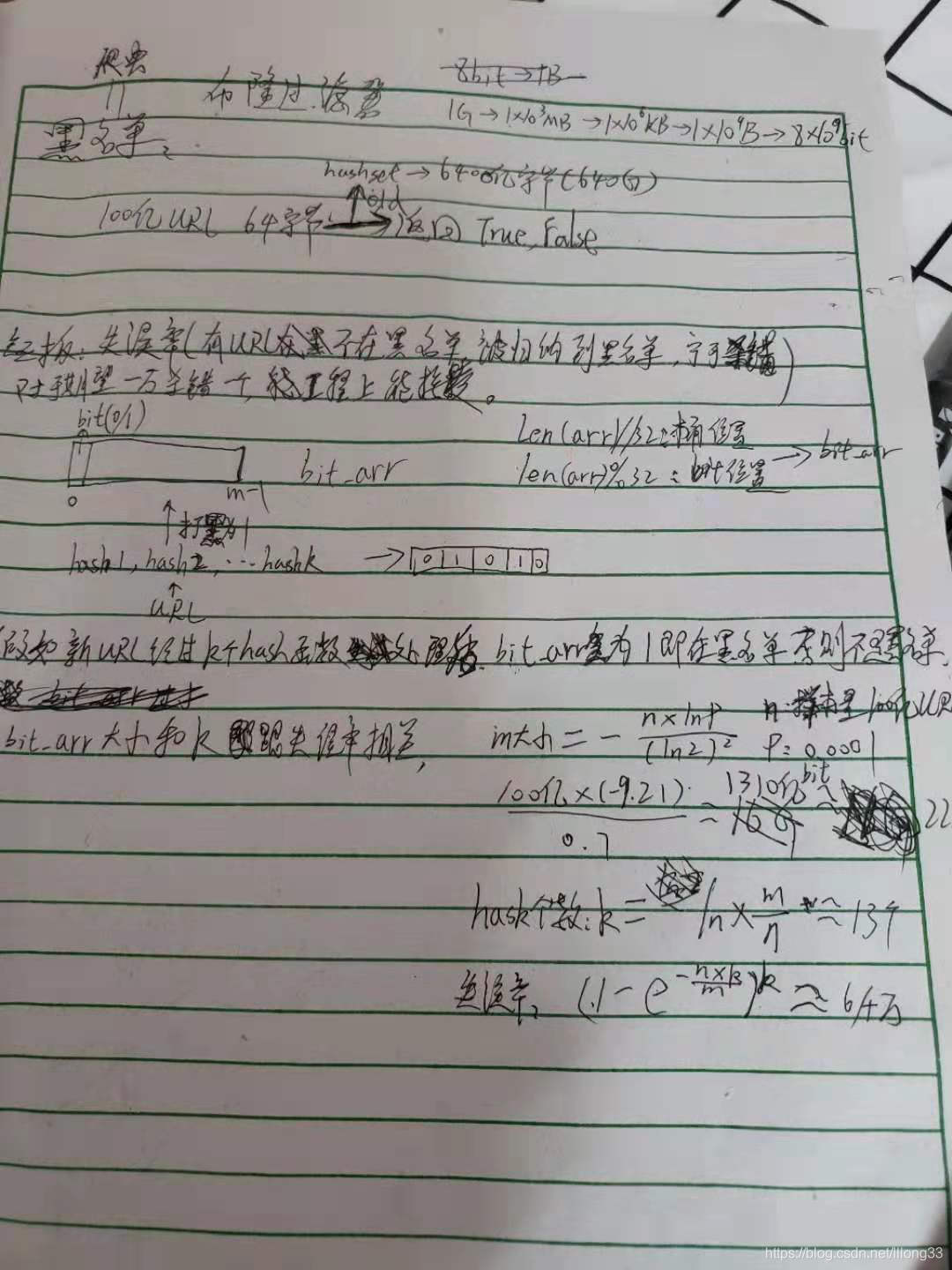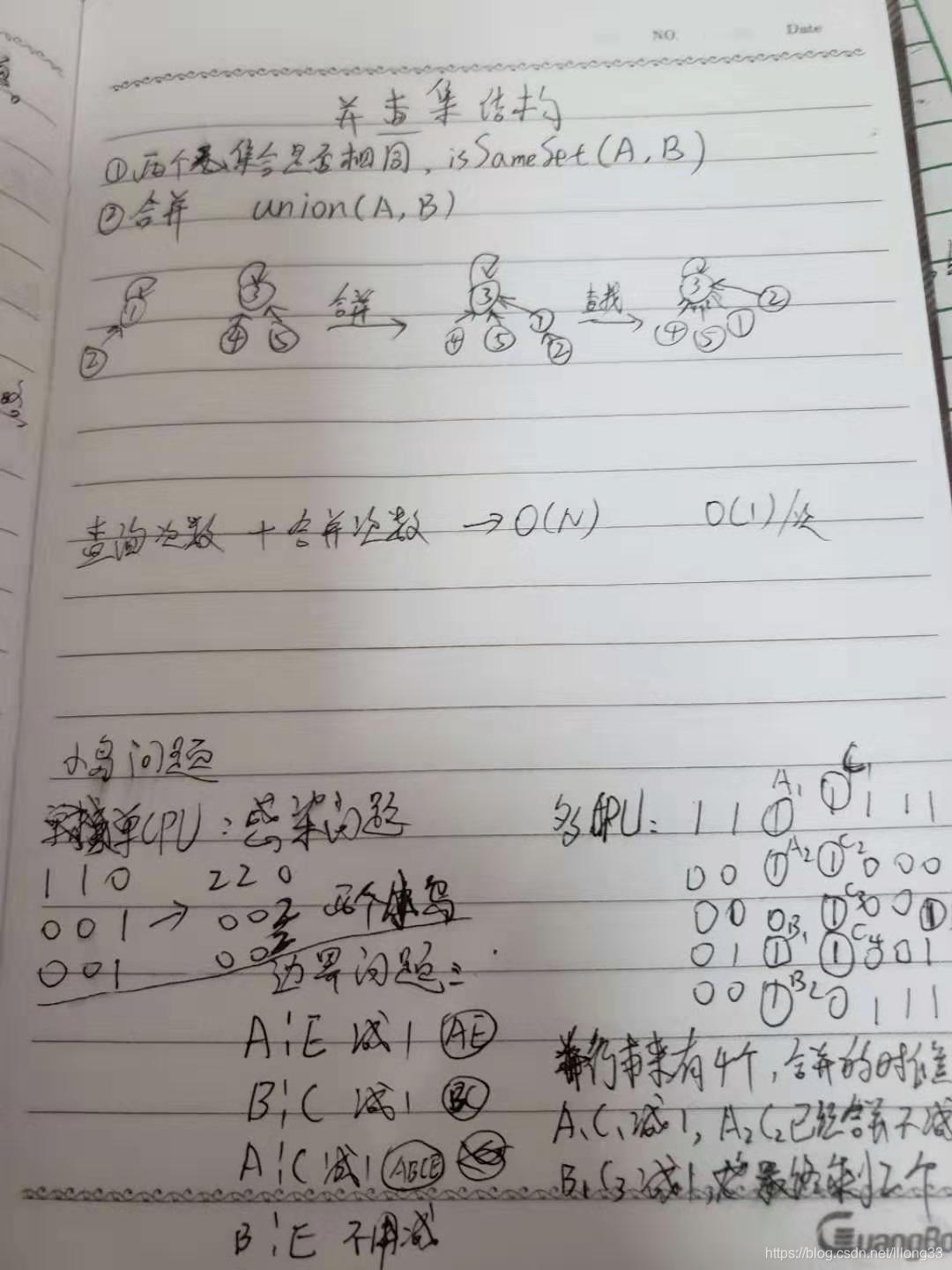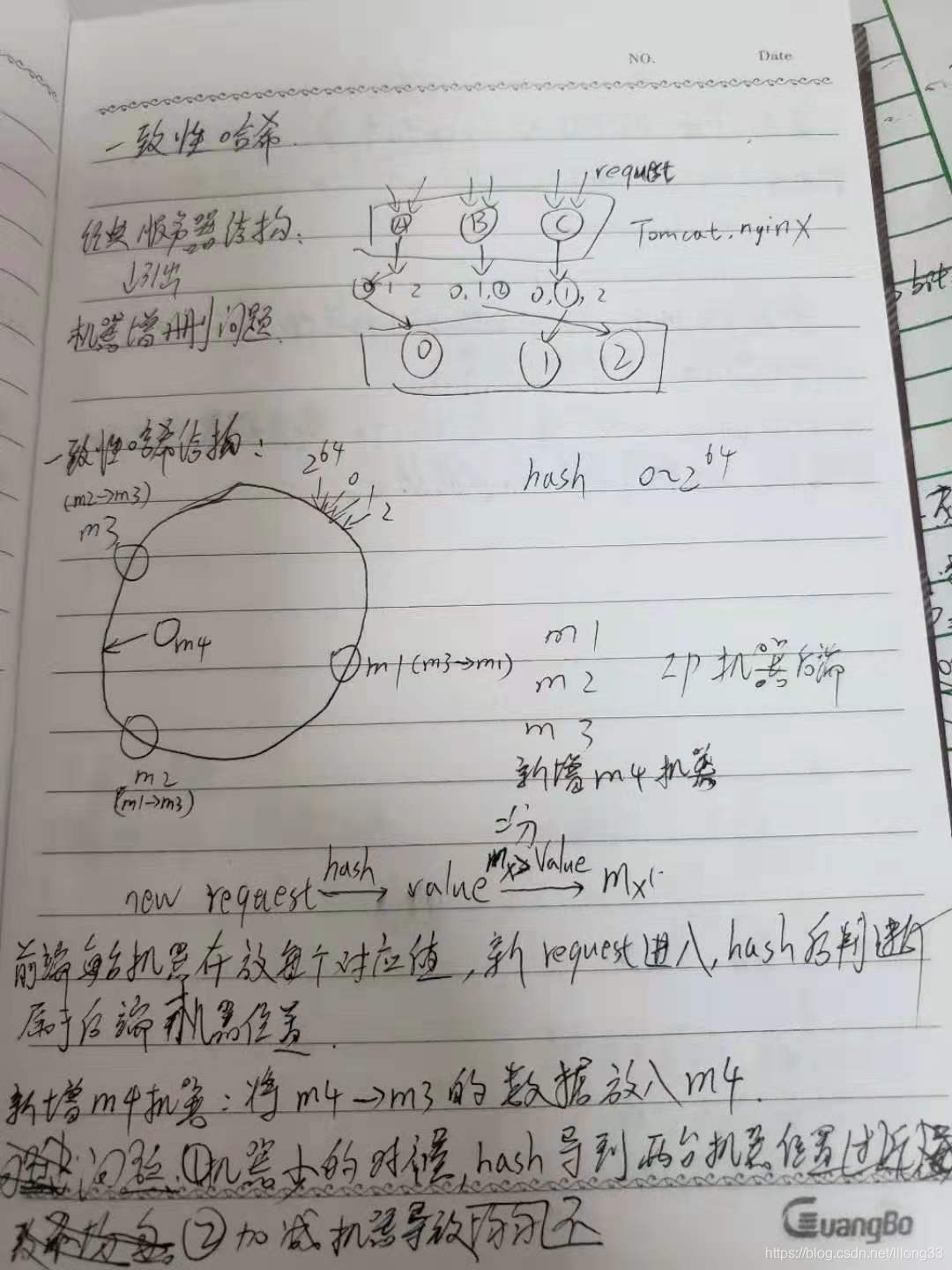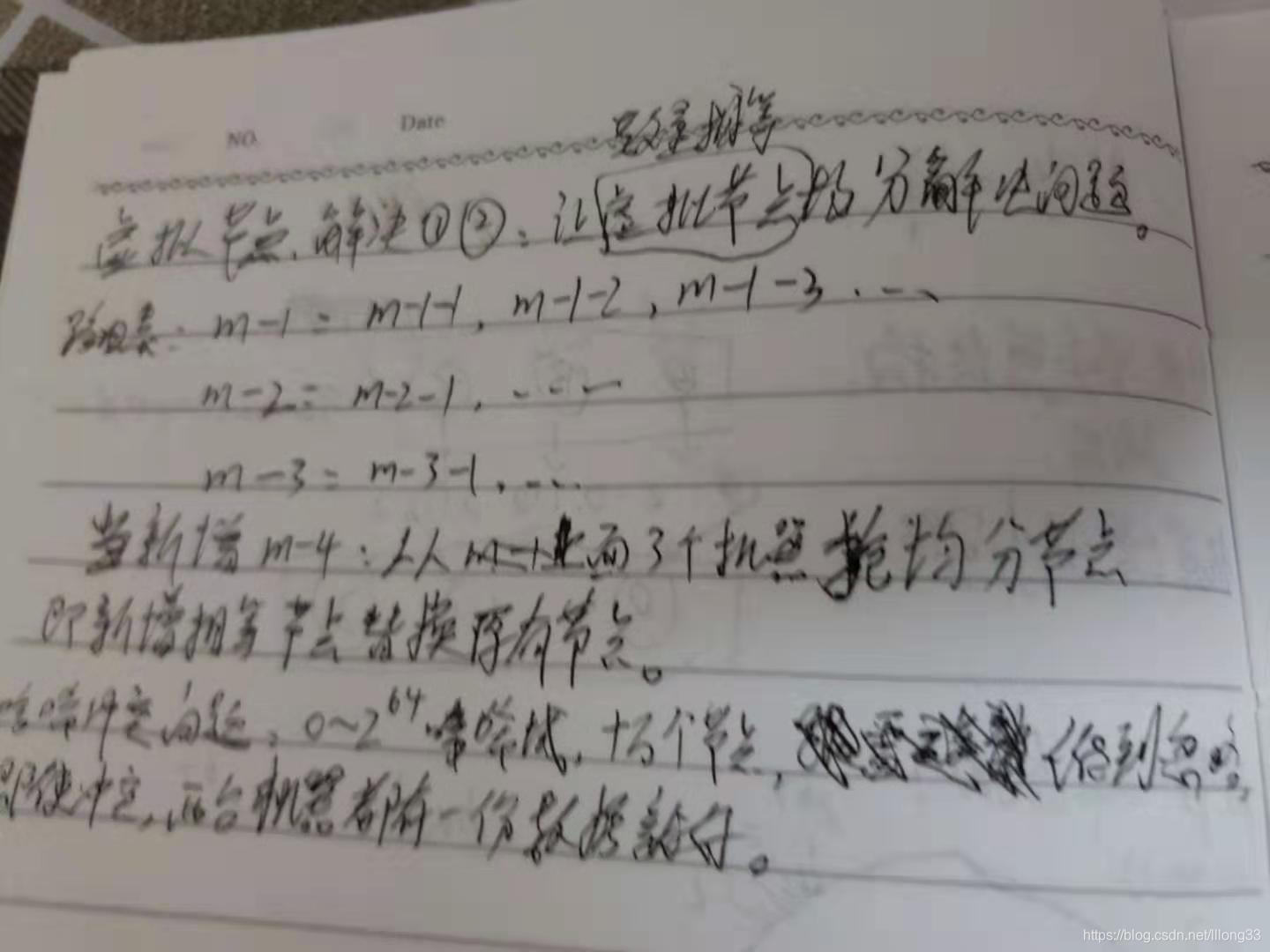哈希函数: 又称散列算法、哈希函数,是从任何一种数据中创建小的数字“指纹”的方法。
- 将消息或数据压缩成摘要,使得数据量变小,将数据的格式固定下来。
- 或者说,即MD5、SHA等函数,实现将大集合映射为随机的小集合。
- 小集合具有均分性
哈希函数的技巧
- 16进制的数,
0-f中的一个数, 取值范围[0,16*16=2**64-1) - 输入无穷大,输出固定
- 哈希冲突,两个不同输入对应一个输出
- 当输入域很大,输出值会有均匀出现返回值
- 经过哈希后得到一个16位的数,将16位分为两组高8位h1和低8位h2(或者用两个哈希函数md5和SHA),由于每位都独立,就有
h1+n*h2=x1,即可获取1000个哈希函数
哈希表: 根据键(Key)而直接访问在内存存储位置的数据结构。存放记录的数组称做哈希表(散列表)。
- 计算一个关于键值的函数,将所需查询的数据映射到表中一个位置来访问记录,这加快了查找速度。
- 将新增值不断磨到表的范围中,将数据挂在相应位置。
- 扩容和JVM的红黑树。前者复杂度可以到O(1),本身是O(logN),离线扩容可以达到O(1)。默认看做O(1)
1、设置RandomPool结构
【题目】 设计一种结构,在该结构中有如下三个功能:
insert(key):将某个key加入到该结构,做到不重复加入。
delete(key):将原本在结构中的某个key移除。
getRandom():等概率随机返回结构中的任何一个key。
【要求】 Insert、delete和getRandom方法的时间复杂度都是O(1)
思路:准备两个字典,分别为key-index和index-key,用size变量实现getRandom,对于delete操作,即将最后一行放置要删除的位置。
class RandomPool:
def __init__(self):
self.key_index = {}
self.index_key = {}
self.size = 0
def insert(self, key):
if not self.key_index.__contains__(key):
self.key_index[key] = self.size
self.index_key[self.size] = key
self.size += 1
def delete(self, key):
if self.key_index.__contains__(key):
delete_index = self.key_index.get(key)
last_index = self.size - 1
last_key = self.index_key.get(last_index)
self.key_index[last_key] = delete_index
self.index_key[delete_index] = last_key
self.key_index.pop(key)
self.index_key.pop(last_index)
def get_random(self):
if self.size == 0:
return None
import random
random_index = int(random.random() * self.size) # 0~size-1
return self.index_key.get(random_index)
def main(self):
pool = RandomPool()
pool.insert("A")
pool.insert("B")
pool.insert("C")
print(pool.key_index, pool.index_key)
pool.delete('A')
print(pool.key_index, pool.index_key)
print(pool.get_random())
print(pool.get_random())
print(pool.get_random())
print(pool.get_random())
RandomPool().main()
2、并查集结构
- 1、判断两个集合是否相同。判断的同时,将所有节点都直接指向头节点
- 2、合并两个集合
- 时间复杂度:查询次数 + 合并次数 = O(N),即O(1)/次
class UnionFind:
def __init__(self):
self.father_map = {}
self.size_map = {}
def make_sets(self, nodes):
self.father_map = {}
self.size_map = {}
for node in nodes:
self.father_map[node] = node
self.size_map[node] = 1
def find_head(self, node):
father = self.father_map.get(node)
if father != node:
father = self.find_head(father)
self.father_map[node] = father
return father
def is_same_set(self, a, b):
return self.find_head(a) == self.find_head(b)
def union(self, a, b):
if a is None or b is None:
return
a_head = self.find_head(a)
b_head = self.find_head(b)
if a_head != b_head:
a_set_size = self.size_map.get(a_head)
b_set_size = self.size_map.get(b_head)
if a_set_size <= b_set_size:
self.father_map[a_head] = b_head
self.size_map[b_head] = b_set_size + a_set_size
else:
self.father_map[b_head] = a_head
self.size_map[a_head] = b_set_size + a_set_size
def main(self):
nodes1 = [1,2,3,4,5,6]
self.make_sets(nodes1)
self.find_head(1)
self.union(1,2)
print(self.is_same_set(1, 3))
self.union(3, 4)
self.union(2,4)
print(self.is_same_set(1,3))
print(self.father_map)
print(self.size_map)
UnionFind().main()
3、岛问题
一个矩阵中只有0和1两种值,每个位置都可以和自己的上、下、左、右
四个位置相连,如果有一片1连在一起,这个部分叫做一个岛,求一个
矩阵中有多少个岛?
思路:直接遍历,碰到数字1就执行infect()函数,并递归执行,将上下左右碰到的1感染为2。然后继续遍历。
"""
Author: lllong33
data: 2019/7/1
"""
class IsLandas:
def count_is_lands(self, m):
if m is None or m[0] is None:
return 0
col = len(m)
row = len(m[0])
res = 0
for i in range(col):
for j in range(row):
if m[i][j] == 1 :
res += 1
self.infect(m, i, j, col, row)
return res
def infect(self, m, i, j, col, row):
if i<0 or i>=col or j<0 or j>=row or m[i][j]!=1:
return
m[i][j] = 2
self.infect(m, i+1, j, col, row)
self.infect(m, i-1, j, col, row)
self.infect(m, i, j+1, col, row)
self.infect(m, i, j-1, col, row)
def main(self):
m1 = [[0, 0, 0, 0, 0, 0, 0, 0, 0],
[0, 1, 1, 1, 0, 1, 1, 1, 0],
[0, 1, 1, 1, 0, 0, 0, 1, 0],
[0, 1, 1, 0, 0, 0, 0, 0, 0],
[0, 0, 0, 0, 0, 1, 1, 0, 0],
[0, 0, 0, 0, 1, 1, 1, 0, 0],
[0, 0, 0, 0, 0, 0, 0, 0, 0]]
print(self.count_is_lands(m1))
m2 = [[0, 0, 0, 0, 0, 0, 0, 0, 0],
[0, 1, 1, 1, 1, 1, 1, 1, 0],
[0, 1, 1, 1, 0, 0, 0, 1, 0],
[0, 1, 1, 0, 0, 0, 1, 1, 0],
[0, 0, 0, 0, 0, 1, 1, 0, 0],
[0, 0, 0, 0, 1, 1, 1, 0, 0],
[0, 0, 0, 0, 0, 0, 0, 0, 0]]
print(self.count_is_lands(m2))
IsLandas().main()
高级技巧:多CPU处理,注意边界问题处理。需要图展示
4、一致性哈希
经典服务器结构:前台多台服务器负载均衡(Tomcat, Nginx),后台多台服务器接受并处理,中间通过磨一定的数均匀分配。
1、经典结构存在问题:增删机器,引出数据拷贝问题
一致性哈希结构:通过哈希函数,会存在0 - 2**64-1个结果,构造一个环。假设三台机器,均匀分配到一个值。下次新增机器,只需将新增机器到临近的机器中间数,拷贝到新机器。
2、引出分配不均问题:可能刚开始三台机器就过近,或者新增机器相邻太近。
虚拟节点解决问题1和2:在一致性哈希的基础上,每台机器创建相同虚拟节点,去0 - 2**64-1中抢数据。新增机器也创建相同节点,通过覆盖之前节点解决不均匀分配问题。
5、布隆过滤器












 本文深入探讨哈希函数的概念,包括其在压缩数据、解决冲突及均匀分布数据中的应用。同时,介绍了几种高效的数据结构,如哈希表、并查集、随机池等,以及在解决实际问题中的运用,例如岛问题的计数。此外,还讲解了一致性哈希和布隆过滤器等高级技巧。
本文深入探讨哈希函数的概念,包括其在压缩数据、解决冲突及均匀分布数据中的应用。同时,介绍了几种高效的数据结构,如哈希表、并查集、随机池等,以及在解决实际问题中的运用,例如岛问题的计数。此外,还讲解了一致性哈希和布隆过滤器等高级技巧。
















 8万+
8万+

 被折叠的 条评论
为什么被折叠?
被折叠的 条评论
为什么被折叠?








